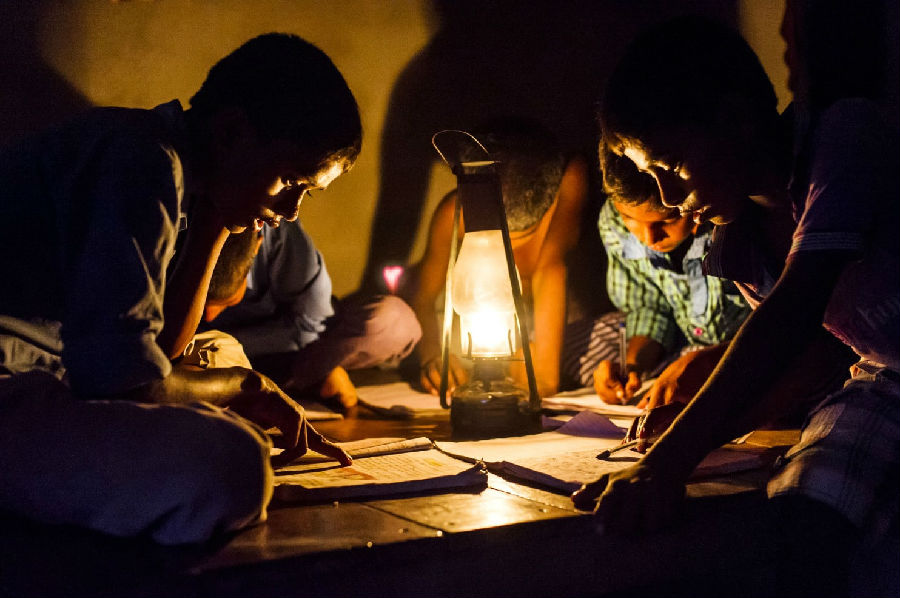India’s last village goes electric, but millions still see dim returns
印度最后一個村莊也通上了電,但仍有數(shù)百萬人看到黑暗歸來
EVERY VILLAGE IN INDIA NOW HAS ACCESS to electricity, Prime Minister Narendra Modi said on April 29,
4月29日,納倫德拉·莫迪總理宣布,印度的每個村莊現(xiàn)都已通上了電,
one day after a remote village in Manipur, northeast India, was added to the national grid.
就在一天前,印度東北部曼尼普爾的一個偏遠村莊也接入了國家電網。
It was a symbolic victory for Modi,
這對莫迪來說堪稱一次象征性的勝利,
who promised in August 2015 to electrify every Indian village within 1,000 days.
因為他曾在2015年8月承諾,要在1000天內讓印度的每個村莊都通上電。
He described April 28 as a “historic day in the development journey of India”—
他說,4月28日是“印度發(fā)展進程中歷史性的一天”——
but more work is needed to bring the country fully into the electric age.
然而,要使這個國家完全進入電力時代,還有很多工作要做。
(First of all)CHARGING AHEAD
(首先)向前沖
Modi was elected in 2014 on the back of pledges to modernize rural areas and improve living standards.
莫迪承諾實現(xiàn)農村地區(qū)的現(xiàn)代化,提高人們的生活水平,2014年他就是這樣當選的。
At that time, roughly 270 million people in India lacked electricity—
當時,印度大約有2.7億人用不上電——
accounting for just under a third of the global access deficit.
幾乎占到了世界無電人口的三分之一。
The gap hindered economic growth, education and health care.
這一差距阻礙了經濟增長、教育和醫(yī)療保健等多方面的發(fā)展。
But while Modi has hit his target,
然而,盡管莫迪的目標已經達成,
the government only requires 10% of a village’s houses and public places to be electrified to count.
但政府在統(tǒng)計的時候,只要求一個村莊有10%的房屋和公共場所通電就可以納為已通電村莊。

By that standard, nearly 97% of India’s roughly 600,000 villages already met the criteria in 2014.
按照這個標準,2014年的時候,印度近60萬個村莊就已經有近97%的村莊達標了。
(And then)IN THE DARK
(其次)茫茫黑夜
Millions of Indians, particularly in remote villages, still rely on dangerous kerosene lamps.
數(shù)以百萬計的印度人,特別是偏遠村莊的村民,現(xiàn)在依然要靠危險的煤油燈照明。
Just six of India’s 29 states, including Kerala and Gujarat, have all homes on the grid,
印度的29個邦中只有6個邦——包括喀拉拉邦和古吉拉特邦在內——的所有家庭都已通電,
according to recent government data.
最近的政府數(shù)據(jù)顯示。
In poorer states such as Jharkhand, more than half of households have no power lines,
在恰爾肯德邦那樣的貧困地區(qū),超過一半的家庭都沒有安裝電線,
while those that do experience hours of blackouts every day.
即便是已經安上了的人家,每天也要經歷數(shù)小時的停電困擾。
(And then)AMPING UP
(最后)
Modi has announced a $2.5 billion plan to electrify all households by the end of December 2018—
莫迪已經宣布了一項斥資25億美元,在2018年12月底之前,也即在議會選舉幾個月前,
just a few months ahead of parliamentary elections.
讓所有印度家庭都用上電的計劃。
The challenge is steep:
然而,這一計劃面臨著無比巨大的挑戰(zhàn):
poorer Indian households struggle to afford the high cost of electricity;
一是較為貧困的印度家庭難以負擔高昂的電費;
the Modi government would need to install connections at a much faster rate;
二是莫迪政府也需要大力加快安裝電網的步伐;
and state-owned power companies are already saddled with debt.
三是印度的國有電力公司已經負債累累了。
But with states like Uttar Pradesh, where 44% of households lack electricity, holding the biggest representation in Parliament,
不過,在北方邦那種44%的家庭都沒通電的地區(qū)在議會中占據(jù)著最大的勢力的情況下,
Modi is hoping that fulilling his promise of “Power for All” will lead his party to a bright political future.
莫迪希望,履行“人人用電”的承諾這一舉措能夠帶領他的政黨走向光明的政治未來。
譯文由可可原創(chuàng),僅供學習交流使用,未經許可請勿轉載。


